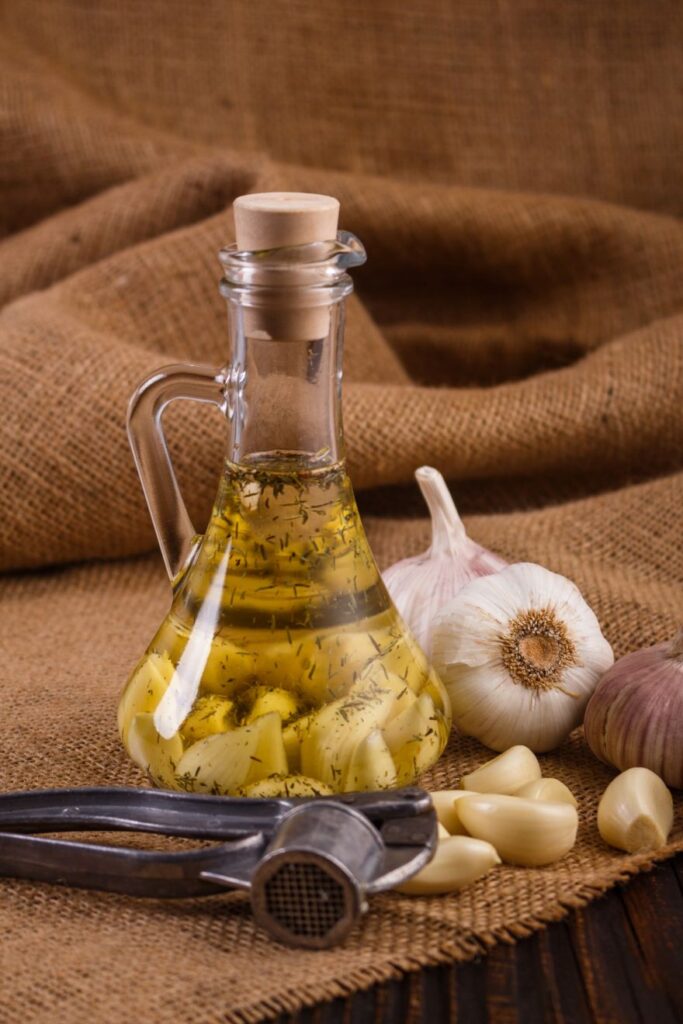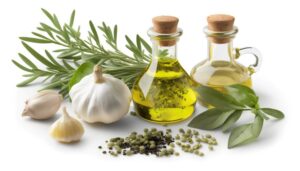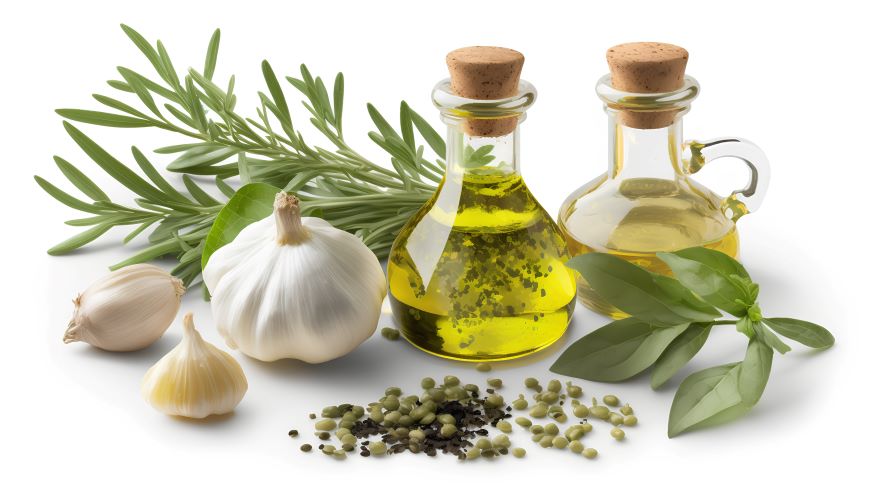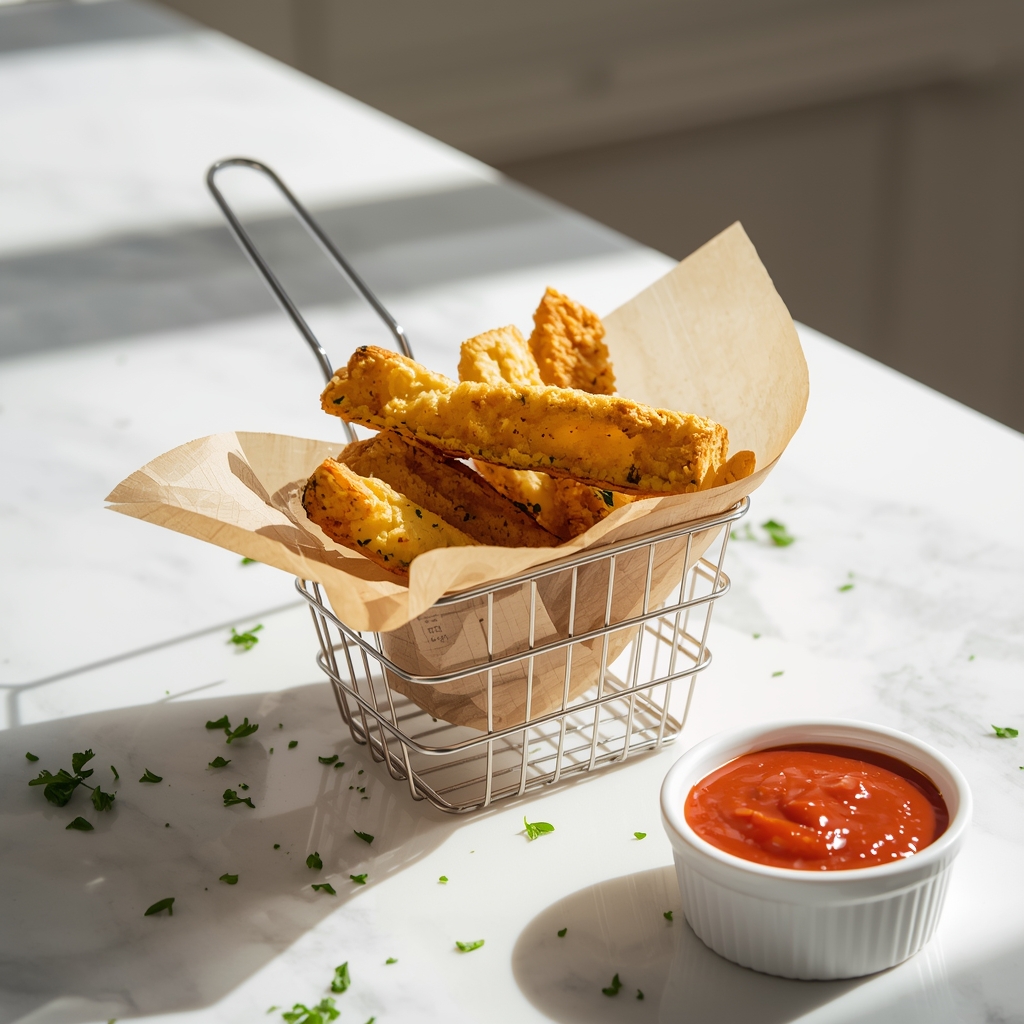Garlic vinegar is a unique and flavorful infusion that combines the well-known health benefits of garlic with the tanginess of vinegar. People use this versatile condiment not only to add a punchy kick to a variety of dishes but also as a natural remedy for a range of health concerns. By simply allowing garlic cloves to steep in vinegar, they can use the resulting infusion to support the immune system, lower blood pressure, and promote heart health.
Preparing the vinegar at home is quite easy, and white wine or apple cider vinegars work best as a base. This simple concoction has been widely used in different culinary traditions across the world, and its usage can be adapted conveniently to suit diverse tastes and ingredients. Apart from its culinary appeal, it functions as a convenient method to harness the medicinal properties of garlic without any complex preparation or unwanted side effects.
Key Takeaways
- Garlic vinegar offers both culinary appeal and health benefits, including immune system support and heart health promotion.
- Preparing garlic vinegar at home is simple, making it an accessible addition to your cooking repertoire.
- This infusion adapts well to a range of culinary preferences, allowing you to enjoy a natural remedy in various dishes.
Health Benefits of Garlic Vinegar
Garlic vinegar is a wonderful addition to your diet, not only for its flavor, but also for the numerous health benefits it offers. Incorporating the vinegar into your food can help boost your immune system, making it easier for your body to ward off common colds. I’ve found that vinegar has medicinal uses and antiglycemic effects, which may further contribute to the health benefits of garlic vinegar.
Another area where this vinegar shines is in promoting heart health. It is known to contribute to improved blood circulation and maintaining healthy blood pressure levels. By incorporating garlic vinegar into your meals, you’re taking a step towards a healthier heart.
Inflammation is a common issue in our bodies and can lead to various health problems if not addressed. The vinegar’s anti-inflammatory properties can help combat inflammation, providing a natural way to improve overall well-being.
All in all, incorporating garlic vinegar into your diet is a simple yet effective way to boost your health. Its immune-supporting, heart-healthy, and anti-inflammatory properties make it a valuable addition to your meals.
Preparation and Usage
As a garlic lover, I’ve discovered that garlic vinegar is both an easy-to-make and versatile ingredient to have in my kitchen. In this section, I’ll guide you through the process of preparing the vinegar and share some usage tips.
Preparing Garlic Vinegar
To make garlic vinegar, you’ll need the following ingredients:
- Garlic cloves
- White wine vinegar or apple cider vinegar
- Optional: salt and water, depending on your taste preferences
First, I like to crush or finely chop the garlic cloves to release their flavors. Once that’s done, I combine the crushed garlic with white wine vinegar or apple cider vinegar in an airtight container. After securing the lid, I store the mixture in the refrigerator overnight to infuse the vinegar with the garlic’s robust flavor. If desired, you can add a bit of salt and water to adjust the vinegar’s taste. For instance, if the garlic or vinegar is too harsh, start with a 1:2 ratio of vinegar to water and adjust accordingly.
Usage of Garlic Vinegar
Once your vinegar is prepared, there are numerous ways to utilize it in your daily cooking. Some of my favorite uses include:
- Salad dressings: Add a touch of garlic vinegar to oil, salt, and water for blending it into a light, flavorful dressing.
- Marinades: I love using this vinegar as a marinade for meats, poultry, and vegetables. The acidity of the vinegar helps tenderize the proteins and enhances the flavors.
- Salads: The vinegar can be drizzled over mixed greens or used to marinate vegetables like cucumbers and radishes before tossing them in a salad.
- Dipping sauces: One can also create wonderful dipping sauces by combining the vinegar with oil, salt, and herbs. This versatile mixture can be perfect for bread dipping, drizzling over roasted vegetables, or even used as a simple sauce for pasta dishes.
- Cookbooks: Garlic vinegar can be a great addition to numerous recipes found in many cookbooks, enhancing flavors, and providing extra depth to your culinary creations.
Overall, I enjoy using garlic vinegar as a staple in my kitchen for its incredible versatility and unique, bold flavor infusions.
Storage and Shelf Life
When it comes to preserving garlic, I’ve found that there are several effective methods to ensure its freshness and flavor. In this section, I will discuss those methods and provide tips on how to make your garlic last longer.
I strongly recommend storing garlic in a cool, dark place away from sunlight. An airtight container is ideal for keeping moisture and bacteria at bay. A fun and flavorful way to store garlic is by storing the cloves in white wine vinegar for three weeks, resulting in soft, aromatic cloves perfect for topping off pasta dishes.
If you have a refrigerator, you can utilize it for storing peeled garlic. However, it’s essential to ensure that you’re placing the garlic in an airtight container before refrigerating. This helps maintain the quality of the garlic and its “meat,”.
Freezing garlic is another option for long-term storage. If you want to freeze your garlic, simply peel the cloves and place them in a plastic freezer bag or an airtight container suitable for freezing. You can also dehydrate garlic by slicing or mincing it, spreading it evenly on a dehydrator tray, and drying it at 115°F (46°C) for 6-8 hours or until completely dry. Store the dried garlic in an airtight container in a cool, dark place to maximize its shelf life.
In my experience, taking these steps to properly store your garlic will help you maintain its flavor, quality, and shelf life. Whether you choose to preserve your garlic in vinegar, refrigerate it, or freeze it, these methods will help you get the most out of your garlic, ensuring that it remains fresh and delicious for your culinary needs.
Potential Side Effects
As a health enthusiast, I recognize the numerous health benefits of garlic vinegar, such as improving cardiovascular health and providing antimicrobial properties. However, it’s essential to consider the potential side effects that some individuals may experience.
Consuming the vinegar may cause a burning sensation in the mouth or throat for some people. This sensation is due to the presence of allicin, a compound with antimicrobial properties. If you experience this uncomfortable feeling, it is advisable to reduce your intake of garlic vinegar and drink water to alleviate the burning sensation.
I should also mention the possibility of gastrointestinal issues. Overconsumption of garlic, in general, can lead to stomach issues, such as bloating, gas, and indigestion. To avoid this side effect, it’s best to consume garlic vinegar in moderation and be mindful of any discomfort that arises after consumption.
Lastly, incorporating this vinegar into your diet can cause bad breath, an unfortunate but common side effect of garlic consumption. To combat this issue, I recommend brushing your teeth or using mouthwash after consuming dishes with garlic vinegar.
In conclusion, although garlic vinegar has numerous health benefits, it’s crucial to consume it in moderation to avoid potential side effects. Pay attention to your body’s reactions and adjust your intake accordingly.

Conclusion
In my experience, garlic vinegar is not only a versatile and flavorful addition to various dishes, but it also provides numerous health benefits. I have found that incorporating garlic vinegar into my meals has led to a boost in my immune system, helping me fend off colds and other respiratory issues. Additionally, it has been useful in combating heavy metal toxicity in my body.
When it comes to preparation, I’ve discovered that using fresh organic garlic and experimenting with different vinegar ratios yields the best results. Allowing the mixture to sit for an extended period enhances the flavors, and straining out the garlic creates a smoother texture that is easier to incorporate into recipes.
Regarding storage, I have learned that preserving garlic in vinegar is an excellent way to extend its shelf life. The vinegar helps reduce the growth of harmful bacteria like E. Coli, ensuring the garlic remains safe to consume. I store my garlic vinegar in a cool, dry place, making sure it is sealed in an airtight container to preserve its quality.
As a confident and knowledgeable home cook, I can confidently say that garlic vinegar has transformed my culinary creations, providing a balance of sharpness and sweetness in dressings, marinades, and dips. The health benefits are an added bonus, making garlic vinegar not only a delicious but a wise choice for my overall well-being.
Frequently Asked Questions
How to prepare chili garlic vinegar sauce?
I start by crushing a few garlic cloves and finely chopping some red chili peppers. Then, I heat white or apple cider vinegar in a saucepan until it reaches a simmer. I pour the hot vinegar over the chopped garlic and chili peppers in a sterilized glass jar. I seal the jar tightly, let it cool completely, and store it in a cool dark place for at least two weeks to allow the flavors to develop.
What is the recipe for rosemary garlic vinegar?
The recipe for rosemary garlic vinegar is simple; I simply combine a few sprigs of fresh rosemary with crushed garlic cloves into a sterilized glass jar. I heat white or apple cider vinegar until it reaches a simmer, then pour the hot vinegar over the rosemary and garlic in the jar. After sealing tightly, I let the jar cool and store it in a cool dark place for at least two weeks to let the flavors infuse.
What are the uses of wild garlic vinegar?
Wild garlic vinegar can be used in various culinary applications. I enjoy using it as a salad dressing, a marinade for meats, or even as a flavorful addition to dips and sauces. It can also be drizzled over roasted vegetables or used in place of regular vinegar to add a unique garlic twist to any recipe.
What are the benefits of garlic and apple cider vinegar?
The combination of garlic and apple cider vinegar offers several health benefits. Garlic has natural antimicrobial properties and strengthens the immune system, while apple cider vinegar aids digestion and balances stomach acid. Together, they form a powerful natural remedy to help alleviate gastrointestinal issues and improve overall immune function.
How to make pickled garlic?
To make pickled garlic, I start by peeling and trimming fresh garlic cloves. Then, I prepare a pickling solution by heating water, vinegar, and salt until the salt dissolves. I add any desired spices and herbs to the solution, such as bay leaves, black peppercorns, or dill. Then, I pack the garlic cloves into sterilized jars, pour the hot pickling solution over them, and seal the jars. I store the jars in a cool dark place for at least two weeks, allowing the garlic to fully pickle and develop flavor.
What is the process for making black garlic vinegar?
Black garlic vinegar is made by fermenting black garlic cloves in a vinegar solution. First, I obtain black garlic cloves, which are caramelized and aged regular garlic cloves, usually available at specialty stores. Then, I place the black garlic cloves into a sterilized jar and pour heated white or apple cider vinegar over them. I seal the jar and let it cool, then store it in a cool dark place for at least two weeks. This aging process allows the flavors of the black garlic to infuse into the vinegar, creating a unique and rich condiment.

*We may earn a commission for purchases made using our links. Please see our disclosure to learn more.



